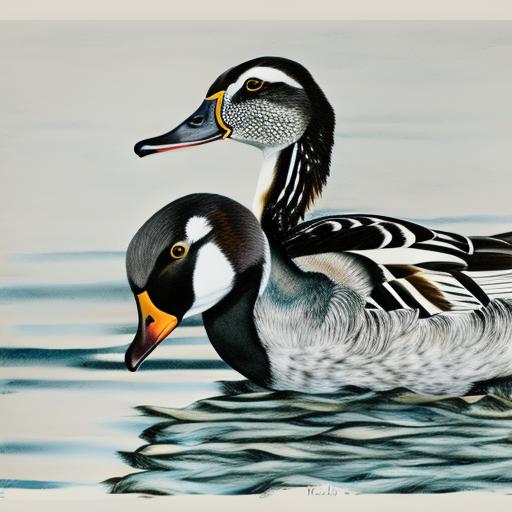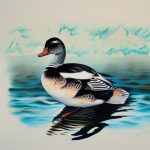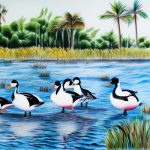Black and white duck breeds have a long history in Michigan, dating back to the early days of European settlement in the region. The state’s abundant wetlands and waterways have always provided an ideal habitat for these waterfowl, making Michigan a prime location for the breeding and hunting of black and white duck breeds. In the 19th and early 20th centuries, ducks were an important source of food and feathers for Michigan’s growing population, and the state became known for its rich duck hunting traditions. Over time, various black and white duck breeds were introduced to Michigan, either through natural migration or deliberate breeding efforts. Today, these breeds continue to play a significant role in Michigan’s ecosystem and cultural heritage.
The history of black and white duck breeds in Michigan is closely tied to the state’s conservation efforts. In the early 20th century, the widespread hunting and habitat destruction led to a decline in duck populations across the United States, including Michigan. In response, conservationists and government agencies began implementing measures to protect and restore duck habitats, leading to the establishment of wildlife refuges and the passage of hunting regulations. These efforts have helped to stabilize duck populations in Michigan and ensure the continued presence of black and white duck breeds in the state’s wetlands and waterways. Today, Michigan remains a popular destination for duck hunting enthusiasts, who flock to the state in search of prized black and white duck breeds.
Key Takeaways
- Black and white duck breeds have a long history in Michigan, with some breeds dating back to the 1800s.
- Common black and white duck breeds found in Michigan include the Black Swedish, Cayuga, and Magpie.
- These duck breeds are known for their hardiness, adaptability, and calm temperament.
- Black and white duck breeds play a crucial role in Michigan’s ecosystem by controlling insect populations and contributing to wetland health.
- When caring for black and white duck breeds in Michigan, it’s important to provide them with access to water, proper nutrition, and protection from predators.
Common Black and White Duck Breeds Found in Michigan
Michigan is home to a diverse array of black and white duck breeds, each with its own unique characteristics and traits. One of the most common black and white duck breeds found in Michigan is the Mallard, known for its distinctive green head and bright orange bill. Mallards are highly adaptable and can be found in a wide range of habitats, from urban ponds to remote marshes. Another popular black and white duck breed in Michigan is the Black Duck, which is similar in appearance to the Mallard but has a darker plumage. Black Ducks are known for their shy and elusive nature, making them a prized target for hunters.
In addition to Mallards and Black Ducks, Michigan is also home to other black and white duck breeds such as the American Wigeon, Northern Pintail, and Gadwall. These ducks can be found in various wetland habitats throughout the state, where they play a vital role in the local ecosystem. Their presence helps to control insect populations, disperse seeds, and provide food for other wildlife. As such, these black and white duck breeds are an integral part of Michigan’s natural heritage and contribute to the state’s rich biodiversity.
Characteristics and Traits of Black and White Duck Breeds
Black and white duck breeds in Michigan exhibit a wide range of characteristics and traits that make them well-suited to their aquatic habitats. One common trait among these breeds is their waterproof feathers, which help them stay buoyant and dry while swimming. Additionally, black and white duck breeds have webbed feet that enable them to paddle through water with ease, making them efficient swimmers. Their bills are also adapted for feeding on aquatic plants, small fish, and insects, allowing them to thrive in wetland environments.
Another notable characteristic of black and white duck breeds is their migratory behavior. Many of these ducks breed in northern regions during the summer months before migrating south to warmer climates for the winter. Michigan’s wetlands serve as important stopover points for migrating ducks, providing them with essential rest and refueling opportunities. This migratory behavior also makes black and white duck breeds a popular target for hunters, who take advantage of their seasonal movements.
The Role of Black and White Duck Breeds in Michigan’s Ecosystem
Black and white duck breeds play a crucial role in Michigan’s ecosystem, contributing to the health and balance of wetland habitats. These ducks are important seed dispersers, as they consume a variety of plant materials and then excrete seeds in different locations, helping to promote plant diversity. Additionally, their foraging activities help to control insect populations, reducing the risk of pest outbreaks in wetland areas. Furthermore, black and white duck breeds serve as prey for various predators, contributing to the overall food web in Michigan’s wetlands.
In addition to their ecological contributions, black and white duck breeds also hold cultural significance in Michigan. Duck hunting has long been a popular pastime in the state, with many hunters valuing the opportunity to pursue these prized waterfowl. The presence of black and white duck breeds in Michigan’s wetlands also attracts birdwatchers and nature enthusiasts who appreciate the beauty and diversity of these birds. As such, these ducks are an integral part of Michigan’s natural heritage and contribute to the state’s reputation as a prime destination for outdoor recreation.
Caring for Black and White Duck Breeds in Michigan
Caring for black and white duck breeds in Michigan involves ensuring that they have access to suitable habitat and resources throughout the year. Wetland conservation efforts are crucial for maintaining healthy populations of these ducks, as they rely on these habitats for breeding, feeding, and resting. Protecting wetlands from pollution, habitat destruction, and invasive species is essential for preserving the ecological balance that supports black and white duck breeds in Michigan.
In addition to habitat conservation, managing hunting pressure is also important for the long-term well-being of black and white duck breeds in Michigan. State wildlife agencies carefully monitor duck populations and set hunting regulations to ensure sustainable harvest levels. These regulations may include limits on bag numbers, hunting seasons, and protected areas to minimize the impact on duck populations while still allowing for recreational hunting opportunities.
Conservation Efforts for Black and White Duck Breeds in Michigan

Conservation efforts for black and white duck breeds in Michigan are led by a combination of government agencies, non-profit organizations, and concerned citizens. These efforts focus on protecting wetland habitats, monitoring duck populations, conducting research on migration patterns, and raising public awareness about the importance of preserving these waterfowl species. State wildlife agencies work closely with federal partners such as the U.S. Fish and Wildlife Service to implement conservation programs that benefit black and white duck breeds.
Non-profit organizations such as Ducks Unlimited also play a significant role in conservation efforts for black and white duck breeds in Michigan. Ducks Unlimited works to conserve, restore, and manage wetlands across North America, including those in Michigan. Through partnerships with landowners, government agencies, and other stakeholders, Ducks Unlimited helps to secure critical habitat for black and white duck breeds while also promoting sustainable hunting practices.
Hunting and Regulations for Black and White Duck Breeds in Michigan
Hunting regulations for black and white duck breeds in Michigan are carefully managed to ensure sustainable harvest levels while protecting populations from overexploitation. State wildlife agencies set annual hunting seasons based on population surveys and ecological data to determine when hunting can occur without negatively impacting duck populations. These seasons typically coincide with the natural migration patterns of black and white duck breeds, providing hunters with opportunities to pursue these waterfowl during their seasonal movements.
In addition to setting hunting seasons, state wildlife agencies also establish bag limits that specify the maximum number of ducks that hunters can harvest each day. Bag limits are designed to prevent excessive take of ducks while still allowing for recreational hunting opportunities. Furthermore, certain areas may be designated as waterfowl refuges where hunting is prohibited to provide sanctuary for ducks during critical times such as breeding or migration.
In conclusion, black and white duck breeds have a rich history in Michigan, where they continue to play a vital role in the state’s ecosystem and cultural heritage. Through conservation efforts, habitat protection, and sustainable hunting practices, Michigan is working to ensure that these waterfowl species thrive for generations to come. By valuing the contributions of black and white duck breeds to the natural world, Michigan can maintain its reputation as a premier destination for outdoor enthusiasts while also preserving its unique biodiversity.
If you’re interested in raising black and white duck breeds in Michigan, you may also want to check out this informative article on the best practices for setting up a chicken coop. The article provides valuable insights on the SnapLock Chicken Coop, where to put a chicken coop, and interior ideas for optimizing the space. It’s a great resource for anyone looking to create a comfortable and efficient living environment for their poultry. Check it out here!
FAQs
What are some black and white duck breeds commonly found in Michigan?
Some black and white duck breeds commonly found in Michigan include the Magpie duck, the Cayuga duck, and the Swedish duck.
What are the characteristics of Magpie ducks?
Magpie ducks are medium-sized ducks with distinctive black and white markings. They are known for their friendly and docile nature, making them popular for backyard flocks.
What are the characteristics of Cayuga ducks?
Cayuga ducks are known for their iridescent black plumage that can appear greenish in certain lighting. They are a hardy breed and are known for their calm and friendly temperament.
What are the characteristics of Swedish ducks?
Swedish ducks, also known as Blue Swedish ducks, have a striking black and white color pattern. They are known for their good egg-laying abilities and calm disposition.
Are black and white duck breeds suitable for backyard flocks in Michigan?
Yes, black and white duck breeds such as the Magpie, Cayuga, and Swedish ducks are suitable for backyard flocks in Michigan. They are hardy, friendly, and can adapt well to various climates.
Meet Walter, the feathered-friend fanatic of Florida! Nestled in the sunshine state, Walter struts through life with his feathered companions, clucking his way to happiness. With a coop that’s fancier than a five-star hotel, he’s the Don Juan of the chicken world. When he’s not teaching his hens to do the cha-cha, you’ll find him in a heated debate with his prized rooster, Sir Clucks-a-Lot. Walter’s poultry passion is no yolk; he’s the sunny-side-up guy you never knew you needed in your flock of friends!







